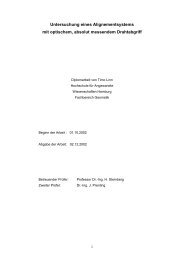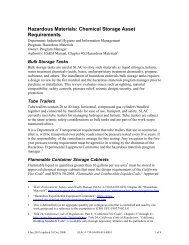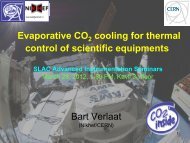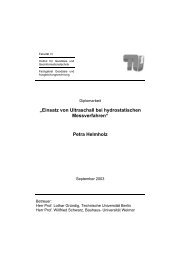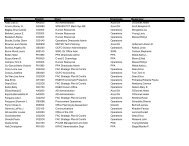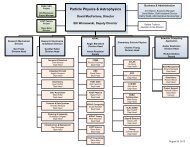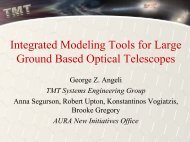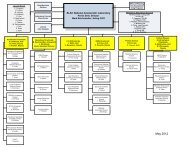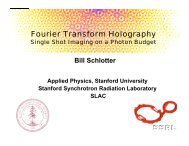BES - SLAC Group/Department Public Websites - Stanford University
BES - SLAC Group/Department Public Websites - Stanford University
BES - SLAC Group/Department Public Websites - Stanford University
You also want an ePaper? Increase the reach of your titles
YUMPU automatically turns print PDFs into web optimized ePapers that Google loves.
FYO7 <strong>SLAC</strong> S CIENCE AND T ECHNOLOGY S ELF E VALUATION<br />
development in magnetism and has been observed in resistance measurements. So far, however, the<br />
nanoscale magnetization distribution during the switching process has remained hidden. We imaged<br />
for the first time, the magnetic switching process using advanced pump-probe x-ray microscopy. We<br />
observe that the switching process is initiated and determined by the lateral motion of a magnetic<br />
vortex driven by the spin current. Motion pictures with 200 picosecond time resolution show that the<br />
switching process is based on the motion of a magnetic vortex, leading to C-like patterns which may<br />
decay later into a uniform magnetic state. Our measurements show the fundamental role played by<br />
the curled Oersted field which necessarily accompanies the spin injection current.<br />
Resonant X-ray Scattering: We plan to explore the nonperturbative x-ray probe limits in solids<br />
using resonant soft x-ray scattering to determine the complex refractive index as a function of x-ray<br />
pulse fluence. The resonant aspect of the x-ray scattering combines the structural with the electronic<br />
and magnetic information of the system. The latter makes this technique highly sensitive to changes<br />
in the electronic structure. The electronic structure responds to the excitation of core electrons and<br />
the successive secondary processes on the time scales of the x-ray pulse duration (femtosecond<br />
regime). We will investigate the earliest stages of radiation chemistry in liquids (primarily water),<br />
extending from a few femtoseconds to many picoseconds. Prior pulsed electron beam studies of<br />
radiolysis have not covered this temporal range, and the fs optical laser studies cannot produce the<br />
electron cascade fundamental to the interaction of EUV/soft x-ray radiation in water.<br />
Catalysis: The microscopic understanding of heterogeneous catalysis requires a detailed<br />
understanding of the dynamics of elementary processes at surfaces including adsorption, formation of<br />
different intermediates, and desorption, which can be stimulated by laser pumping and then probed<br />
with XES or X-ray Photoelectron Spectroscopy (XPS) using FEL soft x-ray pulses. During the<br />
reaction there are important charge and energy transfers between the different adsorbates and the<br />
catalytic substrates that determine many of the important steps. Ultrafast pump (optical lasers) and<br />
probe (FEL-XES, XPS) experiments can be used to identify short lived reaction intermediates,<br />
inaccessible to a more conventional and static XES and XPS. From detailed knowledge of the<br />
electronic structure, how the electrons flowed between the substrate and reactants can be derived and<br />
related to changes in the nuclear coordinates.<br />
Collaborations<br />
PULSE has a very large number of active collaborations.<br />
PULSE contributor: Y. Acremann;<br />
Title: Magnetic Imaging;<br />
Collaboration partners and institutions: Olaf Henrik, Hitachi, Steffan Eisebitt, DESY<br />
PULSE contributor: A. R. Nielsson;<br />
Collaboration partners and institutions: Prof. Lars G.M Pettersson, Stockholm <strong>University</strong>,<br />
Sweden; Dr. Michael Odelius, Stockholm <strong>University</strong>, Sweden, Prof. Lars Ojamäe,<br />
Linköping <strong>University</strong>, Sweden; Prof. Shik Shin, Tokyo <strong>University</strong>, Japan, Dr. Yoshi<br />
Harada, Spring 8, Japan; Dr. Osamu Takahashi, Hiroshima <strong>University</strong>, Japan<br />
PULSE contributors: Y. Acremann, H.C. Siegmann, J. Stöhr;<br />
Title: Transformation of a Metal into an Insulator: Breakdown of Ohm’s Law in High<br />
Electric Fields;<br />
Collaboration partners and institutions: S. J. Gamble, Mark H. Burkhardt, <strong>SLAC</strong>, <strong>Stanford</strong><br />
<strong>University</strong>, and <strong>Department</strong> of Applied Physics, <strong>Stanford</strong> <strong>University</strong>,; Walter A. Harrison,<br />
<strong>Department</strong> of Applied Physics,; A.B. Kashuba, Landau Institute for Theoretical Physics;<br />
Rolf Allenspach, IBM Research, Zurich Research Laboratory; Stuart S. P. Parkin, IBM<br />
Almaden Research Center.<br />
PULSE contributors: Y. Acremann, H.C. Siegmann, J. Stöhr;<br />
Title: Ultrafast High Resolution Magnetic Microscopy;<br />
Collaboration partners and institutions: J. Katine, M.J. Ceary, Hitachi Global Storage, San<br />
Jose; T. Tylisczczak, ALB Berkeley<br />
F I N A L P A G E 2 1



